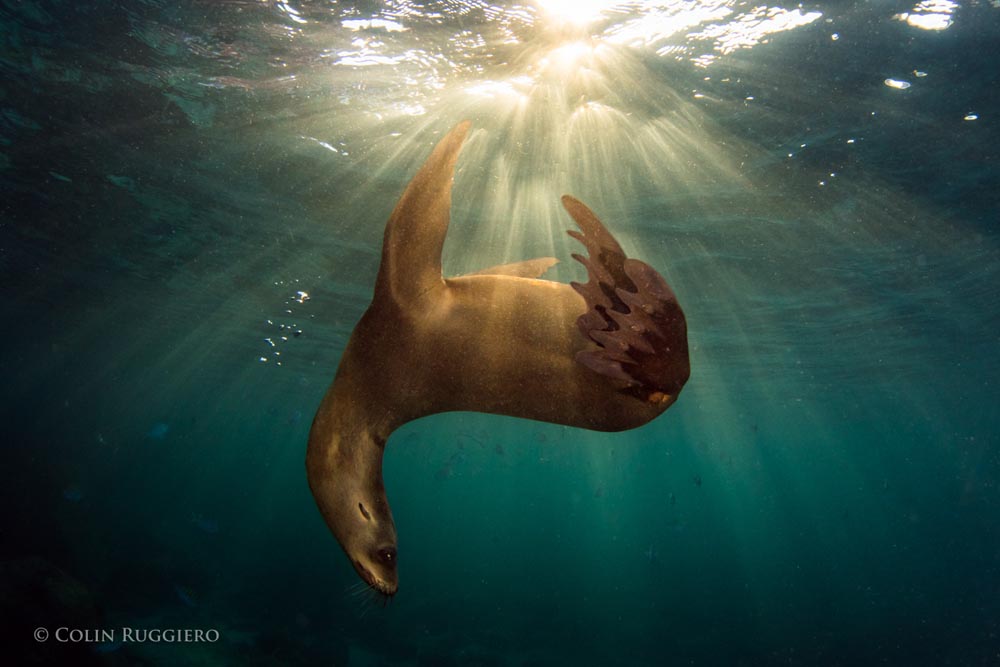
The Successful Sea Lions of Los Islotes
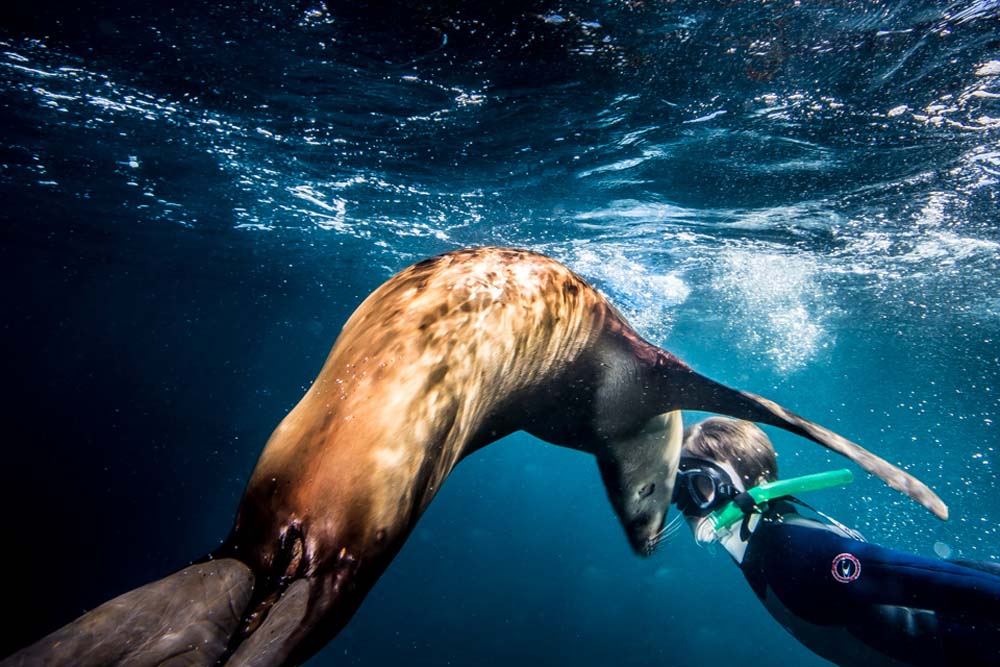
Photo by Erika Peterman
by Bryan Jáuregui for the Journal del Pacifico
Swimming with the sea lion puppies at Los Islotes, the southernmost rookery of the California Sea Lion, Zalophus californianus, is truly one of life’s great joys. The puppies are often playful and naughty, nibbling on the flippers and fingers of human visitors, while their teenage siblings like to sidle up to humans for a good belly rub or game of chase. Their mothers may be found sunning themselves on the rocks, enjoying a snooze, while the males who rule the 20 territories of Los Islotes indefatigably patrol the waters to ensure everyone’s safety. It is a scene of utter Baja bliss, and humans can’t help but feel a magical glow from this most wondrous of wildlife encounters.
All of which begs the obvious question: Why are the males working so hard when everyone else is just having a good time?
Claudia J. Hernandez-Camacho, a professor of biology at CICIMAR in La Paz, has been studying the sea lions of Los Islotes and the Sea of Cortez since 1990. In particular, she has studied the entire lifespan of 190 sea lion individuals (94 females, 96 males) who were hot-branded by her professor between 1980 and 1984. Her findings, based on these specific sea lions and others, tell a complicated tale for our pinniped friends.
“Sea lions are polygynous, meaning that one male mates with several females in the territory that he defends on land and sea. It takes an enormous amount of energy to defend this territory, and in the breeding season a territorial male, who is so focused on his job that he barely eats or sleeps, can lose up to 30% of his impressive body weight (400 to 500 kilos, or about a ton) in just a few weeks.”
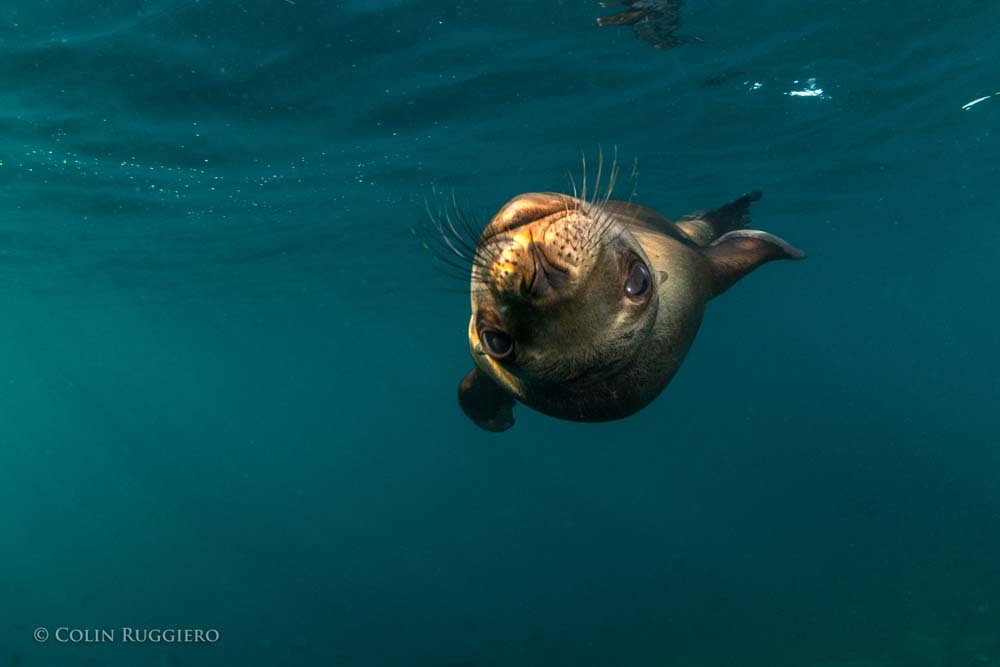
Photo by Colin Ruggiero for Todos Santos Eco Adventures
One would assume, of course, that the males are spending this incredible amount of energy to defend their harems and offspring, to ensure the survival of their genes. “But this is not exactly the case” says Claudia, “they are defending the territory, not the females.” The science proves this out. “Genetic studies show that just 15% of territorial males are the fathers of the newborns the next breeding season. It is not just that the females hook up with and get impregnated by wandering, opportunistic males when they slip off for their 4-5 day feeding trips, which they do, but in some cases the territorial males are not even copulating with the females in their territory.” All that work and no sex?
“It’s a little more complicated than that,” says Claudia. “There are 600 individual sea lions at Los Islotes, and every year around 170 pups are born. Almost 30% of the pups die in the first two years, either from disease or because they or their mothers have fallen prey to predators. But that means that 70% are surviving. With this type of situation, many of the sea lions are, by definition, related. It could be argued that the Los Islotes males work so hard not just for their own offspring, but because they are protecting their extended families. This would also explain why they do not copulate with all the females in their territory. They are avoiding inbreeding.” This is an approach to collective living that we generally only associate with high intelligence mammals like primates, elephants and dolphins.
The Los Islotes territorial males are so successful in their defense of the colony, and have made conditions so conducive to survival, that Los Islotes is actually full to capacity now. In fact, two new satellite colonies have been created nearby in recent years by all the young males who are no longer welcome at Los Islotes, but who are still too young and slight to fight older, larger males for territory. Sea lions are philopatric, meaning that they stay in or habitually return to the area of their birth, so it is possible that these satellite colonies will only continue to grow.
What makes this all the more remarkable is that it is happening at a time when the overall population of California Sea Lions in the Sea of Cortez is dropping dramatically. Between 2000 and 2018, 40% of the population of other colonies disappeared. Are those males falling down on the job? Not likely says Claudia. “We are analyzing a lot of
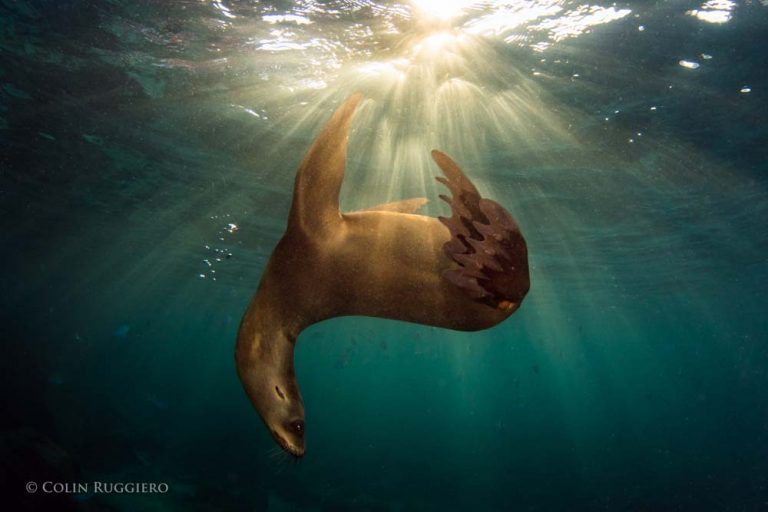
Photo by Colin Ruggiero for Todos Santos Eco Adventures
environmental variables right now to determine the main factor causing the decline of these colonies, but one of the most likely culprits is the food supply” she observes. “It is not that the fish populations in the other parts of the Sea of Cortez are declining, they are not. It is that the fish are moving further south. While the sea lions of Los Islotes, the southernmost California Sea Lion rookery, are benefitting from this trend, it is proving lethal to others. Healthy females will travel up to 60 kilometers away from their colonies to find food, but further than that is not feasible. They need to conserve energy to produce milk for their pups. And even in those more northern locations where there are still fish, there are a very limited number of fish species, and this relatively poor-quality diet means that the females are not gaining enough energy from their food to productively nurse their pups. On the opposite side of the coin, the sea lions of Los Islotes are getting an increasing number of fish species in their diet, with the result that population density has reached an all-time high.”
Female sea lions are not only philopatric, i.e., prone to stay in the area where they were born, they are attached to very specific real estate in that area, with many staking one specific rocky outcropping for their own. So with the increasing density of the population at Los Islotes, it is not surprising to learn that sea lion attitudes are becoming a bit more aggressive. Add to that the fact that the entire colony of females either a) goes into estrus, or b) has newborn pups to defend at exactly the same time and breeding season, which generally takes place June 1 to August 31, becomes a time when human body parts might best be kept at a distance from the sea lions of Los Islotes. In fact, Los Islotes is now closed to snorkelers and scuba divers during this period.
Los Islotes is regularly listed as one of the top diving/snorkeling spots in the world, and Claudia and her students are launching a study to evaluate the effects of all these visitors on the sea lions. The tourism hiatus being imposed by the authorities during breeding season offers them the perfect opportunity for their research. “We have already collected fecal samples from the sea lions during the tourist season, and will now do so again when the colony is closed to tourists. We will then test the level of cortisol, a stress indicator, in both sets of fecal matter to determine if tourism increases stress in sea lions. We have already observed some differences in behavior in the sea lions at Los Islotes. While at other, more remote colonies, the sea lions will copulate during the day, at Los Islotes they only engage in this behavior at night. We hope to be able to determine if tourism is having an impact on the sea lions.”
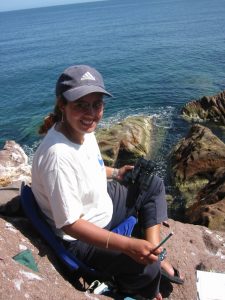
Claudia at Los Islotes
Of course, liking your loving in the evening time is a common enough attribute of many healthy mammals, but if other colonies are also enjoying some afternoon delight, have the sea lions of Los Islotes gone too far in adapting to the presence of humans? Will the territorial males one day snap back to impose a more natural environment for their territories? Human males have certainly done battle over lesser issues.
Tourists have been visiting Los Islotes on a regular basis for roughly three decades, and sea lion males live an average of 19 years. There is therefore not yet a deep institutional knowledge about humans among the territorial males, and they could still be giving us the opportunity to demonstrate our worthiness as visitors to their home. Will we make the cut? We can’t be sure what the sea lions have learned about humans over the years, or what Claudia and her team will demonstrate, but the strong pull of Los Islotes on humans is easy enough to understand: it is a place where joy and spontaneity rule, and we thrill to that vibrancy. While the territorial males are likely not motivated by their roles as life coaches for humans, it is enticing to think that maybe just one of the reasons they work so hard is to protect such a joyful lifestyle for their families. Claudia and her team are working hard to do the same.
VISIT WITH CLAUDIA AND HER TEAM!
Todos Santos Eco Adventures is the leading eco adventure company in Baja California Sur. On Isla Espiritu Santo we operate Camp Cecil, a luxury tent camp, and Camp Colossus, a moveable glamping operation. Claudia and her students will be spending time with us at our camps throughout the season as they conduct their sea lion research, so you may find them at the dinner table if you spend time with us at the island!
© Copyright Sergio and Bryan Jauregui, Casa Payaso S de RL de CV, 2018
